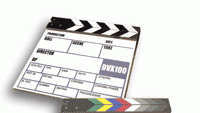Saving shot data

Recording shot data on tape using camera-specific dry-erase slates is more reliable than writing camera notes, but the slates are cumbersome.
Choosing film parameters used to be fairly simple: Just pick an emulsion. With this one choice you could specify the film speed, graininess, resolution, color rendition, latitude and color temperature. But modern professional video cameras offer a range of parameters that were previously unavailable. Producers who now work in video must select frame rate, shutter percent, gain, gamma, pedestal, black stretch, knee point, knee slope, dynamic level, saturation, color correction, white balance, matrix table, filters, camera setups, memory-card setups, number of users, and many other parameters, all of which affect the outcome of the image. I own such a camera. And, after purchasing an upgrade for it, I suddenly felt the weight of all those small decisions.
The camera is the Varicam (AJ-HDC27F), the updated version of the “27V” DVCPRO HD camcorder. With the upgrade, Panasonic has introduced new options that add functionality to programming the camera.
Shooting pains
My first project after receiving my upgrade, a feature-length film with a “reality” dimension to it, provided an interesting test for the new technology. It required me to shoot at least half the film in a controlled situation and half in a run-and-gun documentary (ENG) style. I had one prep day, during which I created four programs that I stored in the camera for the production.
Three months later, I had to get some pickup shots on that first movie and match the look of the previous shots. Good thing I stored the programs. I'm safe. Or am I?
Memory problems
Get the TV Tech Newsletter
The professional video industry's #1 source for news, trends and product and tech information. Sign up below.
How could I possibly remember all the choices I had made and recover them later? Even selecting one of the 12 programs I had stored didn't help, since I had made numerous tweaks during production. In addition, on run-and-gun assignments I don't get a camera assistant, so keeping extensive notes on each shot is impossible. On small indie productions it's pretty much the same. On a properly crewed production it's less of a problem, but it's still an issue. No one is trained to keep those kinds of notes and, ultimately, doing so is very time-consuming.
I thought good camera notes might solve the problem, but it's so much bigger than that. Camera notes have a way of separating themselves from the masters over time.
One idea I had was to track the most critical information on a dry-erase slate. The information would then be on the tape and could not get separated from the images. Figure 1 shows mock-ups of the camera-specific slates I use. But I would really prefer a system that is passive and transparent, especially for the larger, menu-heavy broadcast and HD cameras.
A little help, please
I'm calling on manufacturers to consider this problem and develop solutions that track this data for us. I have it on expert advice that there are several workable possibilities:
- Record the data through a camera port to a PDA that can be attached to a printer for archiving printed data and also can be used in the field by assistants.
- Broadcast this data to a slate that will be photographed to tape. The slate will thereby remain with the images for all to see and use in future shoots.
- Store the complete files on the metadata track of the videotape itself and provide users with a way to upload that information from tape to a camera for replication.
For users who regard their programs as proprietary intellectual property, manufacturers could provide an override or on/off function.
A variation on this theme would be to make all the pertinent functions user-assignable to a “my page” menu. This would put all the variants on one, easily accessible menu. Users could select the page for storage or broadcast to the slate or cabling to the PDA without the need to store a lot of other data. This would also facilitate speedy access of the most used data from a single page. Currently, modifying the look of the camera is very time-consuming. All the variables exist on many menu pages, each with submenus. I'd like to be able to access the items that matter most to me all on one page and archive that information for later retrieval.
One method might have advantages over another. But clearly, users need some way of managing this data.
Michael Caporale is a director of photography for 24p digital cinema.
